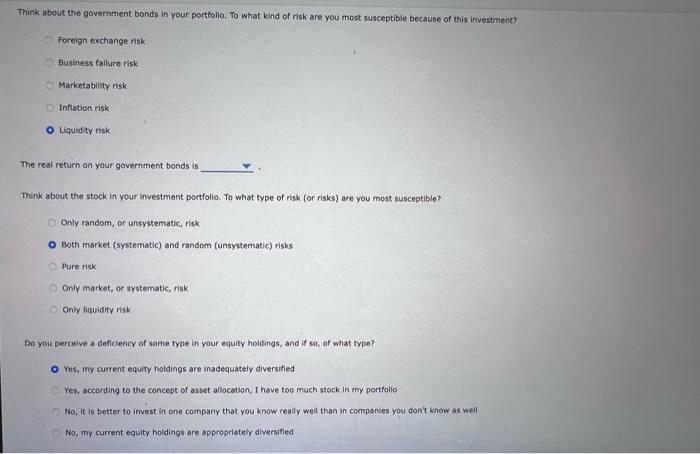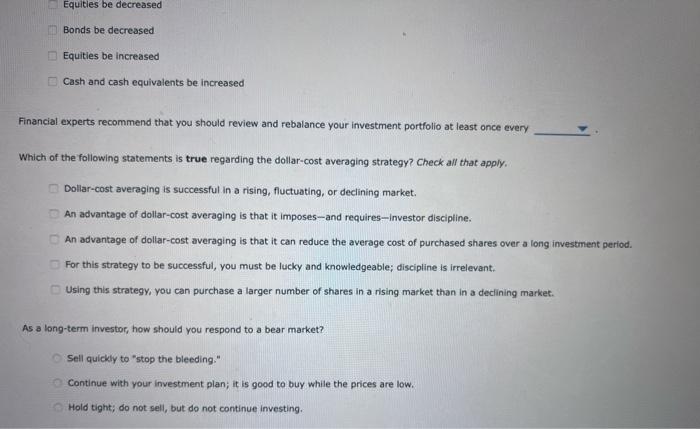Scenario: You are 40 years old. Your investment portfolio currently consists of: (1) a savings account, with a $16,000 balance, (2) certificates of deposit (CDs) worth $20,000, and (3) an investment portfolio consisting of 40% bonds, 40% equities, and 20% cash and cash equivalents. Your bonds are thirty-year U.S. government bonds, while your equities are made up solely of your employer's stock. Your cash holdings consist of your savings account and CDs. Your employer's stock paid a 1% dividend and its market value has increased 10% over the last year. The bonds have paid 4.0% interest. The rate of inflation is 2.75%. Your Investment goals are mainly focused on retirement, and you have no large purchases planned in the short term. The value of your current investment portfolio is bonds, and In equities. This consists of 36,000 in cash and cash equivalents, In Given the existing composition of your investment portfolio, how would you characteristic your investment strategy? Is it conservative, moderate, or aggressive? The investment strategy is aggressive. The investment strategy is conservative. The investment strategy is moderate. Given the existing composition of your investment portfolio, how would you characterize your risk tolerance? Are you risk averse, risk neutral, or risk seeking? O You appear to be risk averse. You appear to be risk seeking You appear to be risk neutral. Think about the government bonds in your portfolio. To what kind of risk are you most susceptible because of this investment? Foreign exchange risk Business failure risk Marketability risk Inflation risk O Liquidity risk The real return on your government bonds is Think about the stock in your investment portfolio. To what type of risk (or risks) are you most susceptible? Only random, or unsystematic risk O Both market (systematic) and random (unsystematic) risks Pure risk Only market, or systematic risk Only liquidity risk Do you perceive a deficiency of some type in your equity holdings, and if so, of what type? Yes, my current equity holdings are inadequately diversified Yes, according to the concept of asset allocation, I have too much stock in my portfolio No, it is better to invest in one company that you know really well than in companies you don't know as well No, my current equity holdings are appropriately diversified Consider the following table of recommended asset allocation percentages of cash/bonds/equity: 0-5 years Risk tolerance / Investment strategy Low risk / Conservative Moderate risk/Moderate High risk / Aggressive 35 / 40/25 20/40/40 10/30/60 6-10 years 20 / 40/40 10/30/60 0/20 / 80 11+ years 10/30 / 60 0/20/ 80 0/0/100 If you believe that the allocation of assets in your portfolio should be modified to meet your retirement needs, then it is recommended that your holding of: Check all that apply. Bonds be increased Cash and cash equivalents be decreased Equities be decreased Bonds be decreased Equities be increased Cash and cash equivalents be increased Financial experts recommend that you should review and rebalance your investment portfolio at least once every Which of the following statements is true regarding the dolar-cost averaging strategy? Check all ick all that apply. Dollar.cost averaging is successful in a rising, fluctuating, or declining market. An advantage of dollar-cost averaging is that it imposes and requires-Investor discipline. An advantage of dollar.cost averaging is that it can reduce the average cost of purchased shares over long investment period Equities be decreased Bonds be decreased Equities be increased Cash and cash equivalents be increased Financial experts recommend that you should review and rebalance your investment portfolio at least once every Which of the following statements is true regarding the dollar-cost averaging strategy? Check all that apply. Dollar-cost averaging is successful in a rising, fluctuating, or declining market An advantage of dollar-cost averaging is that it imposes--and requires-Investor discipline. An advantage of dollar-cost averaging is that it can reduce the average cost of purchased shares over a long investment period. For this strategy to be successful, you must be lucky and knowledgeable; discipline is irrelevant Using this strategy, you can purchase a larger number of shares in a rising market than in a declining market. As a long-term investor, how should you respond to a bear market? Sell quickly to stop the bleeding." Continue with your investment plan; it is good to buy while the prices are low. Hold tight; do not sell, but do not continue investing. Scenario: You are 40 years old. Your investment portfolio currently consists of: (1) a savings account, with a $16,000 balance, (2) certificates of deposit (CDs) worth $20,000, and (3) an investment portfolio consisting of 40% bonds, 40% equities, and 20% cash and cash equivalents. Your bonds are thirty-year U.S. government bonds, while your equities are made up solely of your employer's stock. Your cash holdings consist of your savings account and CDs. Your employer's stock paid a 1% dividend and its market value has increased 10% over the last year. The bonds have paid 4.0% interest. The rate of inflation is 2.75%. Your Investment goals are mainly focused on retirement, and you have no large purchases planned in the short term. The value of your current investment portfolio is bonds, and In equities. This consists of 36,000 in cash and cash equivalents, In Given the existing composition of your investment portfolio, how would you characteristic your investment strategy? Is it conservative, moderate, or aggressive? The investment strategy is aggressive. The investment strategy is conservative. The investment strategy is moderate. Given the existing composition of your investment portfolio, how would you characterize your risk tolerance? Are you risk averse, risk neutral, or risk seeking? O You appear to be risk averse. You appear to be risk seeking You appear to be risk neutral. Think about the government bonds in your portfolio. To what kind of risk are you most susceptible because of this investment? Foreign exchange risk Business failure risk Marketability risk Inflation risk O Liquidity risk The real return on your government bonds is Think about the stock in your investment portfolio. To what type of risk (or risks) are you most susceptible? Only random, or unsystematic risk O Both market (systematic) and random (unsystematic) risks Pure risk Only market, or systematic risk Only liquidity risk Do you perceive a deficiency of some type in your equity holdings, and if so, of what type? Yes, my current equity holdings are inadequately diversified Yes, according to the concept of asset allocation, I have too much stock in my portfolio No, it is better to invest in one company that you know really well than in companies you don't know as well No, my current equity holdings are appropriately diversified Consider the following table of recommended asset allocation percentages of cash/bonds/equity: 0-5 years Risk tolerance / Investment strategy Low risk / Conservative Moderate risk/Moderate High risk / Aggressive 35 / 40/25 20/40/40 10/30/60 6-10 years 20 / 40/40 10/30/60 0/20 / 80 11+ years 10/30 / 60 0/20/ 80 0/0/100 If you believe that the allocation of assets in your portfolio should be modified to meet your retirement needs, then it is recommended that your holding of: Check all that apply. Bonds be increased Cash and cash equivalents be decreased Equities be decreased Bonds be decreased Equities be increased Cash and cash equivalents be increased Financial experts recommend that you should review and rebalance your investment portfolio at least once every Which of the following statements is true regarding the dolar-cost averaging strategy? Check all ick all that apply. Dollar.cost averaging is successful in a rising, fluctuating, or declining market. An advantage of dollar-cost averaging is that it imposes and requires-Investor discipline. An advantage of dollar.cost averaging is that it can reduce the average cost of purchased shares over long investment period Equities be decreased Bonds be decreased Equities be increased Cash and cash equivalents be increased Financial experts recommend that you should review and rebalance your investment portfolio at least once every Which of the following statements is true regarding the dollar-cost averaging strategy? Check all that apply. Dollar-cost averaging is successful in a rising, fluctuating, or declining market An advantage of dollar-cost averaging is that it imposes--and requires-Investor discipline. An advantage of dollar-cost averaging is that it can reduce the average cost of purchased shares over a long investment period. For this strategy to be successful, you must be lucky and knowledgeable; discipline is irrelevant Using this strategy, you can purchase a larger number of shares in a rising market than in a declining market. As a long-term investor, how should you respond to a bear market? Sell quickly to stop the bleeding." Continue with your investment plan; it is good to buy while the prices are low. Hold tight; do not sell, but do not continue investing










